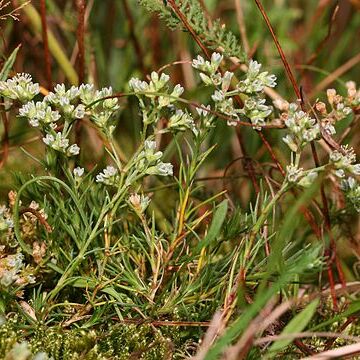Annual, biennial, or perennial herbs. Stems pubescent on one or two opposite sides, procumbent or erect. Leaves exstipulate, very narrow, joined at the base. Inflorescence mostly reduced dichotomous cymes, or flowers solitary in the leaf axils, at the base enveloped by two scarious bracts. Flowers perigynous; hypanthium urceolate, about as long as the sepals. Sepals 4 or 5, with scarious margin. Petals 0. Stamens 1-10, connate at the base, sometimes alternating with staminodes. Ovary 1-ovuled; styles 2 with 2-or 3-branched stigma. Fruit a membranaceous utricle surrounded by the thickened hard hypanthium. Seeds compressed, glabrous with thin testa.
Fls in cymes or solitary, minute and greenish, hermaphrodite. Sepals 4 or 5 from rim of urceolate perig. cup; petals 0; stamens 1-10; ovary 1-celled with 1basal ovule (occ. 2); styles 2, free to base, stigmas 2; fr. an ind. 1(-2)-seeded nutlet enclosed within hardened perig. cup and persistent sepals; seed smooth, lenticular. Annual to perennial, us. densely branched, herbs with small, subulate, opp., connate, exstipulate lvs. Number of spp. variously estimated at from 10 to 150 in Europe, Asia, Africa, S. America, Australia, New Guinea and N.Z. Relationships of N.Z. and Australian forms need clarifying.
Annual, biennial or perennial herbs. Lvs opposite, exstipulate, linear to subulate, connate by narrowly scarious bases. Fls solitary or paired or clustered, on long axillary peduncles or not pedunculate; bracts small, scarious or leaflike; epicalyx 0. Sepals 4-5, inserted on rim of flask-shaped perigynous zone. Petals 0. Stamens 1, 2 or 5-10, inserted on rim of perigynous zone. Styles 2. Fr. a 1-seeded indehiscent nutlet, with perigynous zone and calyx adhering to fr. and falling with it when ripe. Seeds ovoid or ellipsoid, smooth, not winged.
Fls in compact, terminal and axillary cymose clusters, perfect, perigynous, the cupulate hypanthium resembling a cal-tube; sep 5; pet none; stamens 1–10; ovary ovoid; styles 2, distinct; ovule one on a basal placenta; hypanthium becoming indurate in fr, crowned by the persistent sep and enclosing the membranous utricle; seed obovoid, beaked at the micropylar end; low herbs with diffusely forking stems and opposite, exstipulate lvs connate at base. 10, Old World.

